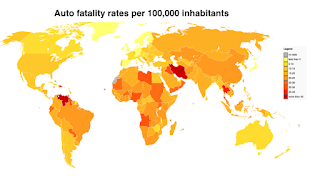How does a brand keep one foot in the past and one foot in the future and thrive today? Brands that focus on delivering consistent brand experiences that transcend categories and time can use those experiences to build a bridge to the future. For these brands, the classic '4P's' of marketing become subordinate to delivering one big 'E'. Over the years, Apple has been a master at this.
 |
| Brand as big 'E' |
In contrast, in the automotive business, all efforts are focused on delivering one big 'P'. Product development gets the lion's share of investment. All the other P's work in service of that product. This is why automotive marketing rarely strays from touting features and benefits. Product is star--the ultimate object of desire, while everything else, including the customer becomes a supporting prop for the product.
This is perhaps part of the reason that automotive marketing, despite a significant shift to digital media, remains stuck in the past. This is perhaps part of the reason that the category is losing relevance. And perhaps part of the reason that automakers are seeing their profits eroded by the need to prop up volume with ever increasing incentives.
And while that's the short term problem, nearly every automaker has acknowledged that their business will be shifting to a mobility services model over the next decade or two. Thus at some point, automotive brands will need to change the category conversation from 'P' to 'E' if they are to survive.
Dictionary.com defines mobility as 'the movement of people in a population, as from place to place, from job to job, or from one social class or level to another'.
Thus, the new automotive conversation will need to shift the focus from car as star to brand as life enhancing tool. The first brand to consistently and credibly do so has the opportunity to claim leadership and define the category on their terms.
And Ford just might have an edge to claim this leadership role.
First, it has established a Smart Mobility subsidiary to focus on delivering future experiences. Second, and perhaps more importantly, Ford has a history and heritage that allows it to credibly lay right to this claim. Henry Ford's vision was not about sheetmetal at all, but rather about affording the common person the opportunity for upward mobility.
Ford's marketing has already dabbled in this territory. Ford's 2017 Superbowl introduced its Smart Mobility services by highlighting the consequence of the absence of mobility in a variety of non automotive life situations. And its tagline 'Go Further' has the potential to punctuate mobility as a life enhancing tool.
But in order for Ford to fully make the move in marketing they must build the bridge from the future to back to today. They must begin to highlight the almost forgotten power of personal mobility by focusing on the life enhancing experiences that all of their cars and trucks bring to customers right now. Ford has the right to become the champion for the millions of Americans who are feeling left behind. The Americans that Ford helps to go further, everyday. By making this shift, the customer becomes the star and the vehicle and other services become the tools to better life experiences...much like the Model T was oh so many years ago.








